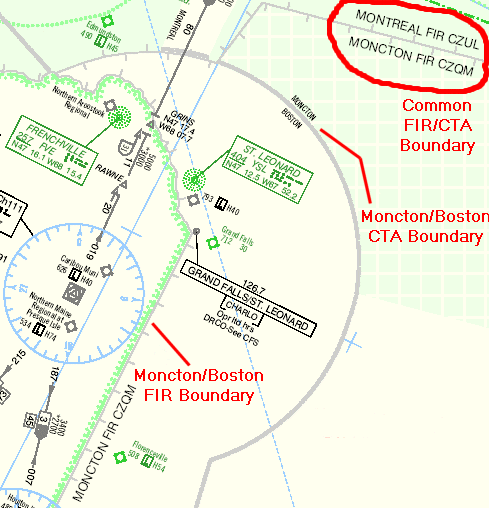
You can see in the diagram at left that the airspace boundary between
Moncton and Montreal ACC's is the same for both the FIR and the CTA (top
right). The boundary between Moncton and Boston, on the other hand, is a
dual boundary. The international boundary serves as the FIR boundary, and
Moncton is therefore responsible for flight information in the area of overlap.
Boston is the one providing Air Traffic Control services and providing separation
there. Because Boston is doing this, it is actually more appropriate for
a pilot to talk to Boston Center for IFR clearance out of this area. It
gets more convoluted for a number of reasons. The aircraft on the ground
at CYSL (St. Leonard), for example, call Quebec Radio for IFR clearance,
since CYSL is in their Area of Responsibility (AOR) and they have a DRCO
there. QB FIC then calls Moncton for IFR, who must then talk to Boston for
clearance. Then the clearance is relayed through Moncton to QB and on to
the aircraft. This is all very cumbersome, prone to delays, and quite outdated.
The airspace was divided like this several years ago when AFB Loring was
active. Now that the base has been shut down and its TCU closed, the airspace
still belongs to Boston, even though it's a pain for both sides of the fence.
In any case, the unit providing the ATC service is the best one to talk
to for IFR clearance.
 You can see in the diagram at left that the airspace boundary between
Moncton and Montreal ACC's is the same for both the FIR and the CTA (top
right). The boundary between Moncton and Boston, on the other hand, is a
dual boundary. The international boundary serves as the FIR boundary, and
Moncton is therefore responsible for flight information in the area of overlap.
Boston is the one providing Air Traffic Control services and providing separation
there. Because Boston is doing this, it is actually more appropriate for
a pilot to talk to Boston Center for IFR clearance out of this area. It
gets more convoluted for a number of reasons. The aircraft on the ground
at CYSL (St. Leonard), for example, call Quebec Radio for IFR clearance,
since CYSL is in their Area of Responsibility (AOR) and they have a DRCO
there. QB FIC then calls Moncton for IFR, who must then talk to Boston for
clearance. Then the clearance is relayed through Moncton to QB and on to
the aircraft. This is all very cumbersome, prone to delays, and quite outdated.
The airspace was divided like this several years ago when AFB Loring was
active. Now that the base has been shut down and its TCU closed, the airspace
still belongs to Boston, even though it's a pain for both sides of the fence.
In any case, the unit providing the ATC service is the best one to talk
to for IFR clearance.
You can see in the diagram at left that the airspace boundary between
Moncton and Montreal ACC's is the same for both the FIR and the CTA (top
right). The boundary between Moncton and Boston, on the other hand, is a
dual boundary. The international boundary serves as the FIR boundary, and
Moncton is therefore responsible for flight information in the area of overlap.
Boston is the one providing Air Traffic Control services and providing separation
there. Because Boston is doing this, it is actually more appropriate for
a pilot to talk to Boston Center for IFR clearance out of this area. It
gets more convoluted for a number of reasons. The aircraft on the ground
at CYSL (St. Leonard), for example, call Quebec Radio for IFR clearance,
since CYSL is in their Area of Responsibility (AOR) and they have a DRCO
there. QB FIC then calls Moncton for IFR, who must then talk to Boston for
clearance. Then the clearance is relayed through Moncton to QB and on to
the aircraft. This is all very cumbersome, prone to delays, and quite outdated.
The airspace was divided like this several years ago when AFB Loring was
active. Now that the base has been shut down and its TCU closed, the airspace
still belongs to Boston, even though it's a pain for both sides of the fence.
In any case, the unit providing the ATC service is the best one to talk
to for IFR clearance.